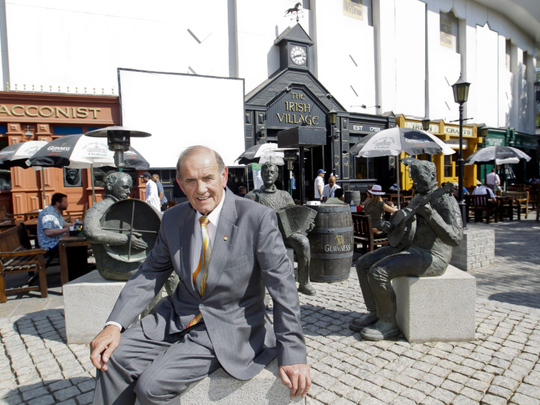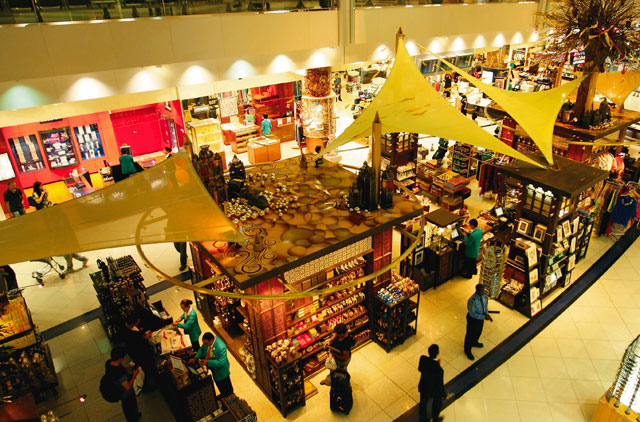
Dubai: Colm McLoughlin loves numbers, and data and statistics. He sits behind his desk in Dubai Duty Free’s office in Umm Ramool, reeling off figures whilst chuckling to himself about how many tonnes of chocolate was sold last year.
“We sold 2,000 tonnes in 2016. How many tonnes a day is that?” McLoughlin asks. We calculate that it equates to over 6 tonnes of chocolate sold every day across Dubai’s airports.
According to the Irishman, who has worked at the retailer since 1983, chocolate is a constant favourite, despite the changing profile of the airport retailer’s customers.
“The biggest contribution to our business now is the subcontinent. There has been terrific growth in other areas, Africa being one of them. But the most noticeable one, and the one people talk about the most, is China.”
Dubai had 450,000 Chinese visitors in 2015, expected to rise to 600,000 in 2016/2017. Despite only accounting for 4 per cent of passenger traffic through the airport, Chinese travellers account for 9 per cent of Dubai Duty Free’s business.
This is reflected in the airport retailer’s staff. Just 10 years ago, there were no Chinese staff working in Dubai Duty Free, now there are 580.
“There are trends that come and go. Like five years ago, Russians accounted for a significant amount of business in Duty Free. And we’d buy certain products to cater to that market. We stocked accessories for motor cars, like pumps and jacks and signs.”
“I remember we used to sell fax machines all the time to Russian passengers! Then this horrendous thing happened with the currencies, so it dropped away. But it’s coming back again,” McLoughlin says.
“We just try to understand what’s popular through our reading and research and so on.”
All eyes on Al Maktoum
He starts listing statistics again: perhaps most importantly he mentions that Dubai Duty Free opened Concourse D, providing 7,000 square metres (sqm) of extra space.
When asked how much more retail space will be opened in the coming years, McLoughlin is happy to provide some numbers.
“We currently have 2,500 sqm of retail space at Al Maktoum International. By end of 2017 that will be 4,000 sqm. By 2022, we will have 80,000 sqm of retail space at Al Maktoum.”
“We expect to have in excess of $3 billion (Dh11 billion) in business at that time, and between 9,000 or 10,000 staff,” McLoughlin says.
In total, Dubai Duty Free has 34,000 sqm of space. By 2022, Al Maktoum will have a new terminal, two new concourses, and three runways in operation. At that point, the new airport will have capacity for 135 million passengers, growing to 240 million after that.
They are currently servicing the airport from their centre in Umm Ramool, but plan to open a separate centre in Dubai World Central eventually.
The cost of business
McLoughlin says that the cost of Al Maktoum International’s retail space will be financed by Dubai Duty Free themselves, either paid out of their own cash, or if necessary with a loan through a conglomerate of local banks.
Despite declining to put an exact figure on the amount, when asked for a ballpark estimate of the amount needed for upcoming Al Maktoum operations, McLoughlin confidently offers up $1 billion.
Asked about the $1.75 billion six-year loan Dubai Duty Free took in 2012, he is quick to clarify a particular point.
“The loans we got in the past were not for Dubai Duty Free operations, they were totally to support and help the infrastructure building at Dubai International, it all went to the Department of Finance” he says.
“The first loan we took was for $1.7 billion with 26 different banks, and the second loan was for $700 million. It was all managed for us by four lead banks who then got other banks to contribute. It was actually oversubscribed.”
Dubai Duty Free is currently servicing those loans.
Spend per head
The best spend per head at any Dubai Duty Free is $42, located on Concourse B of the Emirates-only Terminal 3 at Dubai International. But for the Executive Vice-Chairman of the largest Duty Free operation in the world, the number of people you sell to is more important.
“Penetration is equally as important as spend per head. The best airports in the world are happy to sell something to 18 per cent or 19 per cent of departing passengers. Dubai sells to 40 per cent of them.”
“We sell to more people, and a little bit more to each of them,” McLoughlin says.
Cost-price negotiations
As for most companies, 2016 was a slow year for Dubai Duty Free. The retailer had roughly the same amount of daily transactions as 2015, but spending was down, according to McLoughlin.
He notes that this was caused mostly by currency fluctuations.
“If it’s the same price in dirhams as it was two years ago, it means today it’s more expensive in euros.”
“We’ve been trying to counteract that. We’re in discussions with many of our suppliers, who are cooperating with us, to have the currency exchange reflected in their cost price to us,” he says.
These companies are predominantly European suppliers of perfumes and alcohol, brands that Dubai Duty Free has traditionally paid in Dollars.
“They’ve responded well,” he says. “It took a while but its working now.”
The future
With an increase in visitors to Dubai, and growing middle classes in China and parts of Africa, there is a move away from the luxury segment towards the middle of the market. McLoughlin expects the profile of his customers to change in the coming years to reflect this shift.
“The percentage of our business will become more non-luxury, although we do try to cater to these people already.”
Whilst he is full of optimism for the future (20-25 million visitors to Dubai by 2020, $3 billion in business in not too distant future, and loyal staff are all reasons he lists), Colm McLoughlin does occasionally worry.
“Security is always a concern at airports. Another big concern at the moment is currency fluctuations. We don’t really know what Brexit is going to do to us, and we don’t know what’s going to happen with the euro,” he says.
“We want to rebound, and we don’t want our products to become too expensive for visitors.”











